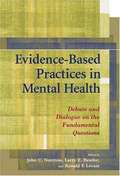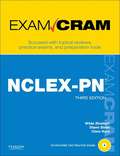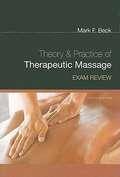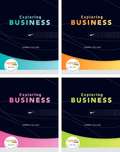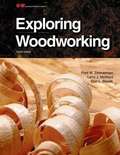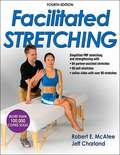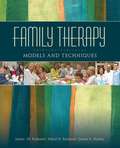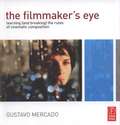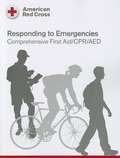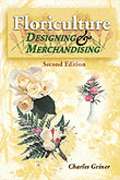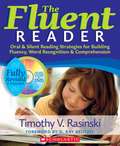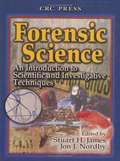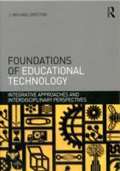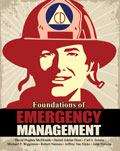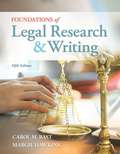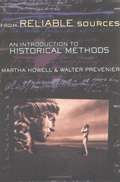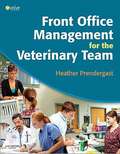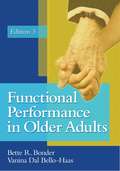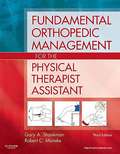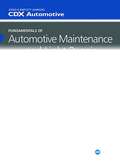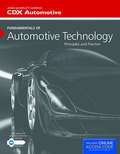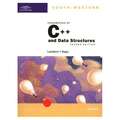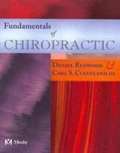- Table View
- List View
Evidence-Based Practices in Mental Health: Debate and Dialogue on the Fundamental Questions
by John C. Norcross Larry E. Beutler Ronald F. LevantAddresses fundamental questions in the debate on evidence-based practices (EBPs) such as What qualifies as evidence? What qualifies as research on which to judge effective practice? Are research patients and clinical trials representative of clinical practice? Are evidence-based treatments readily transportable to clinical practice? and others. Positions are argued with passion and intelligence. Each question-focused chapter concludes with a dialogue among the contributors in which they emphasize their points of agreement and disagreement. The debate, interchange, and dialogue format makes this an ideal tool for teaching and discussion. For mental health practitioners, trainers, and graduate students.
Exam Cram: NCLEX-PN (3rd Edition)
by Wilda Rinehart Diann Sloan Clara HurdSucceed with topical reviews, practice exams, and preparation tools "The book offers a quick 'cram' approach to the NCLEX that is user friendly and not time intensive. The overall approach is learner-centered and the content is well paced. " --Catherine Dearman, RN, PhD Covers exactly what you need to know to score higher on your NCLEX-PN® exam. Includes 400 sample test questions to help you determine whether you're ready to take the actual exam. Our popular Cram Sheet tearcard helps you remember key concepts. Exam Alerts provide important information found on the exam. Simplifies pharmacology for easy learning. Written by Leading Nursing Experts! Wilda Rinehart has R. N. , B. S. N. , M. S. N. , F. N. C. , and F. P. N. P. degrees. Her experience includes staff nurse in surgery, labor and delivery; public-health nurse; and family-planning nurse practitioner. She also was an instructor of surgical and obstetrical nursing. Diann Sloan has R. N. , B. S. N. , M. S. N. , F. N. C. , as well as MS. Ed. and Ph. D. in Education degrees. She has worked as a staff nurse in surgical nursing, pediatrics, and neonatal intensive care and as a pediatric nurse clinician. She has also been an instructor of pediatric and psychiatric nursing. Clara Hurd has M. S. N. , R. N. , and C. N. E. degrees. She has worked with Pearson as a consultant on item writing. She has 31 years of experience and has worked as a staff nurse in medical-surgical nursing and the surgical intensive care unit. Ms. Hurd has taught in associate and baccalaureate nursing programs. Score Higher on the NCLEX-PN® Exam! The CD features innovative Computer Adaptive Testing software, giving you an effective tool to assess your readiness for the NCLEX-PN® exam. Key features include: Detailed explanations of correct and incorrect answers Multiple test modes Random questions and order of answers System Requirements: Microsoft Windows XP, Microsoft Vista or Microsoft Windows 7 Pentium class 1GHz processor (or equivalent) 256MB RAM 30MB Hard Drive Space Category: Test Preparation and Review Covers: Nursing NCLEX-PN® is a registered trademark of the National Council of State Boards of Nursing, Inc. (NCSBN), which does not sponsor or endorse this product.
Exam Review for Beck's Theory and Practice of Therapeutic Massage, 5th edition
by Mark F. BeckThis printed exam review is created to offer students a fast and convenient way to prepare for licensing exams. Tens of thousands of students have successfully used our exam reviews to pass their exams with flying colors. Each exam review contains chapter-by-chapter questions in a multiple-choice format to help students prepare for their exams. The answer key at the back of the book allows students to check accuracy and identify weak areas.
Experimental Design and Data Analysis for Biologists
by Gerry P. QuinnAn essential textbook for any student or researcher in biology needing to design experiments, sample programs or analyse the resulting data. The text begins with a revision of estimation and hypothesis testing methods, covering both classical and Bayesian philosophies, before advancing to the analysis of linear and generalized linear models. Topics covered include linear and logistic regression, simple and complex ANOVA models (for factorial, nested, block, split-plot and repeated measures and covariance designs), and log-linear models. Multivariate techniques, including classification and ordination, are then introduced. Special emphasis is placed on checking assumptions, exploratory data analysis and presentation of results. The main analyses are illustrated with many examples from published papers and there is an extensive reference list to both the statistical and biological literature. The book is supported by a web-site that provides all data sets, questions for each chapter and links to software.
Exploring Business
by Karen CollinsCollins is the only Introduction to Business book to teach students the topics of business through an in-depth study of a single company--Nike. How do you show your students the relationships between what they are learning in the classroom and what happens in the real business world? What happens when your students don't see the connections between the theory they are learning in the classroom and what is happening in the real business world?
Exploring Woodworking (Eighth Edition)
by Fred W. Zimmerman Larry J. Mcward Don L. BlazekExploring Woodworking provides the essential knowledge that beginning students require. It introduces different woods and their characteristics in addition to basic techniques using hand and power tools. Information regarding woodworking operations, such as drilling and sawing, is presented in individual chapters to ensure in-depth coverage. Product designs for woodworking projects are included. An entrepreneurship chapter explains how to organize and operate an in-school manufacturing business, giving students hands-on experience with financing, marketing, and construction. The text also introduces students to the industrial woodworking environment to provide insight into the potential workplace.
Facilitated Stretching (4th Edition)
by Robert McateeFacilitated Stretching, Fourth Edition, remains the most trusted resource for proprioceptive neuromuscular facilitation (PNF) stretching, an effective and easy-to-use method that involves stretching the muscle, contracting it isometrically against resistance, and then stretching it again to increase range of motion. Featuring a full-color interior, streamlined organization, the fourth edition brings PNF stretching beyond the treatment room with the inclusion of techniques for the gym, workout room, and home. The fourth edition offers a visual demonstration of PNF stretching techniques with more than 320 photos and illustrations. It includes these updates: - A full-color interior provides readers with clear images of the techniques discussed - Graphic elements on selected photos highlight the muscles being stretched as well as the isometric effort for the stretcher and the partner - Reorganization streamlines the content into two parts, first focusing on the basics and then covering stretches - Expanded content demonstrates how to incorporate stretches, including strengthening routines, into nontherapy workouts to optimize functional training - An appendix showcases anatomical planes of motion, anatomical terms, and types of joints - Online high-definition video presents both treatment room techniques and simplified PNF stretches for nontherapy settings "Facilitated Stretching, Fourth Edition," examines techniques and guidelines for PNF stretches in a variety of settings. Stretches are demonstrated on a treatment table, mat on the floor, chair, cable-pulley machine, and weightlifting bench. Stretches are grouped according to each joint, and the majority of the stretches include both a partner stretch version and a self-stretch version.
Family Therapy: Models And Techniques
by Janice M. Rasheed James A. Marley Mikal N. RasheedThis text offers a straightforward, comprehensive overview of both traditional and evolving theoretical models of family therapy and intervention techniques as well as a discussion of clinical issues unique to family therapy practice. Aiming to prepare students to develop beginning proficiency in family therapy, the authors outline major family therapy models in detail, including a step by step description of concepts, theories, skills, and techniques as well as a history of each model and its conceptual and theoretical underpinnings. The text also provides extensive case illustrations of family interviews that identify the specific stages, clinical issues, concepts, theories and techniques associated with each model. This core text is designed for graduate level courses such as Family Therapy, Marriage and Family Therapy, Marriage and Family Counseling, Family Systems Theory, and Family Counseling in departments of social work, psychology, nursing, education, or human services.
The Filmmaker's Eye: Learning (and Breaking) the Rules of Cinematic Composition
by Gustavo MercadoThis book combines conceptual and practical instruction on creating polished and eloquent images for film and video with the technical know-how to achieve them. The Filmmaker's Eye is a focused, easy-to-reference guide that shows you how to become a strong visual storyteller through smart, effective choices for your shots.
First Aid: Responding to Emergency (2012 Rev. #12)
by American Red CrossThis participant's textbook is part of the American Red Cross Responding to Emergencies: Comprehensive First Aid/CPR/AED program. The emergency care procedures outlined in this book reflect the standard of knowledge and accepted emergency practices in the United States at the time this book was published.
Floriculture Designing & Merchandising (2nd Edition)
by Charles P. GrinerProvides an introduction to the floral industry, along with basic instructions in the techniques of floral design and merchandising. Coverage is at a high school level, using large type and numerous, sometimes fuzzy b&w illustrations of arrangements. Topics range from careers in the retail flower business, design principles, and flower and plant selection and storage, to arrangements for holidays and weddings, pricing strategies, displays, delivery, and professional organizations. Annotation C. Book News, Inc., Portland, OR (booknews.com).
The Fluent Reader 2nd Ed
by Timothy V. RasinskiTim Rasinski's groundbreaking book has been updated to include coverage of the latest research on fluency, teaching strategies based on that research, new classroom vignettes, and suggestions for using a variety of texts to teach fluency such as poetry, speeches, and monologues and dialogues. You'll also find background information, assessment tools, step-by-step lessons, and teaching tips--plus video clips showing the strategies in action. For use with Grades 1-8.
Fluid Power Systems
by Patrick J. KletteFluid Power Systems is a text/workbook that covers topics specifically relating to the design, application, and maintenance of hydraulic and pneumatic systems. This new edition has been redesigned and includes expanded content on hydraulic pumps, fluid conductors, connectors, and means of transmission. The text/workbook addresses fluid power systems, components, and devices specific to industrial, commercial, and mobile power equipment applications such as pumps, valves, actuators, electrical controls, and troubleshooting techniques. Each component, device, or system is introduced with descriptions, operation, common applications, system examples, and operating characteristics. Schematic symbols are introduced throughout the textbook to assist the learner with schematic diagram comprehension.
Forensic Science: An Introduction to Scientific and Investigative Techniques
by Stuart H. James Jon J. NordbyEncompassing classic criminalistics and the latest techniques, this introductory text presents forensic science with cases and techniques made accessible to nonscientists at the advanced high school and undergraduate level. The text covers forensic pathology and related specialties, evaluation of the crime scene, forensic science in the laboratory, forensic engineering, cybertechnology and forensic science, forensic application of the social sciences, and legal and ethical issues in forensic science. Learning features include quizzes, an extensive glossary, numerous color photos, and appendices on professional guidelines, safety precautions, and web sites. The authors are forensic consultants. Annotation copyrighted by Book News, Inc. , Portland, OR
Foundations of Educational Technology: Integrative Approaches and Interdisciplinary Perspectives
by J. Michael SpectorAn ideal textbook for masters, doctoral, or educational specialist certificate programs, Foundations of Educational Technologyoffers a fresh, project-centered approach to the subject, helping students build an extensive electronic portfolio as they navigate the text. The book addresses fundamental characteristics of educational technology that span various users, contexts and settings; includes a full range of engaging exercises for students that will contribute to their professional growth; and offers the following 4-step pedagogical features inspired by M. D. Merrill's First Principles of Instruction: TELL: Primary presentations and pointers to major sources of information and resources ASK: Activities that encourage students to critique applications and share their individual interpretations SHOW: Activities that demonstrate the application of key concepts and complex skills with appropriate opportunities for learner responses DO: Activities in which learners apply key concepts and complex skills while working on practice assignments and/or projects to be created for their electronic portfolios The first textbook to launch Routledge's new Integrative Approaches to Educational Technologyseries, this indispensible volume covers the core objectives addressed in foundations of educational technology courses.
Foundations of Emergency Management
by David Mcelreath Julie C. Speck Robert Nations Carl J. Jensen [et al.]Covers the following topics: Foundations of Emergency Management History of Emergency Management in the United States Principle Hazards Facing the United States Power and Policy of Stakeholders and First Responders Roles in Emergency Management Strategy Roles in Emergency Management: Volunteer Organizations and NGOs Role of the Emergency Manager and Developing an Effective Emergency Management Organization Preparing for the Inevitable The Emergency Management Process: Risk Perception and Analysis, Prevention, and Hazard Mitigation The Emergency Management Process: Disaster Recovery Professionalization of Emergency Management International Emergency Management Future of Emergency Management
Foundations Of Legal Research And Writing
by Carol M. Bast Margie HawkinsFOUNDATIONS OF LEGAL RESEARCH AND WRITING, Fifth Edition is the ideal resource for paralegals. The book's up-to-the-minute coverage tackles the ever-evolving areas of computer-assisted research and Cyber law, in addition to traditional legal research, analysis, and writing. Extensive research chapters address primary and secondary sources, citating, Lexis/Nexis, the Internet, and more, while writing sections center on drafting client opinion letters, pleadings, contracts, office memos, memoranda of law, and appellate briefs. Every chapter gives you practice writing opportunities, as well as traditional and computer-assisted research assignments to help develop your skills. Detailed case excerpts, samples, tips, and discussions further support the assignments, and illustrate the many perils of inadequate research and poor legal writing. Readers everywhere agree that FOUNDATIONS OF LEGAL RESEARCH AND WRITING, Fifth Edition delivers the concepts you need for success in the most demanding law firms and legal departments today.
From Reliable Sources: An Introduction to Historical Methods
by Martha C. Howell Walter PrevenierFrom Reliable Sources is a lively introduction to historical methodology, an overview of the techniques historians must master in order to reconstruct the past. Its focus on the basics of source criticism, rather than on how to find references or on the process of writing, makes it an invaluable guide for all students of history and for anyone who must extract meaning from written and unwritten sources. Martha Howell and Walter Prevenier explore the methods employed by historians to establish the reliability of materials; how they choose, authenticate, decode, compare, and, finally, interpret those sources. Illustrating their discussion with examples from the distant past as well as more contemporary events, they pay particular attention to recent information media, such as television, film, and videotape. The authors do not subscribe to the positivist belief that the historian can attain objective and total knowledge of the past. Instead, they argue that each generation of historians develops its own perspective, and that our understanding of the past is constantly reshaped by the historian and the world he or she inhabits. A substantially revised and updated edition of Prevenier's Uit goede bron, originally published in Belgium and now in its seventh edition, From Reliable Sources also provides a survey of western historiography and an extensive research bibliography.
Front Office Management for the Veterinary Team
by Heather PrendergastThe only book of its kind, Front Office Management for the Veterinary Team focuses on the day-to-day duties of the veterinary team. It offers a complete guide to scheduling appointments, billing and accounting, communicating effectively and compassionately with clients, managing medical records, budgeting, marketing your practice, managing inventory, using outside diagnostic laboratory services, and much more. Written by Heather Prendergast, RVT, CVPM, this manual simplifies essential tasks with step-by-step instructions! Exercises on the Evolve website offer additional practice with front office tasks. Interactive working forms give you experience completing sample checks, deposit slips, patient history forms, and incident reports. The latest information on electronic banking and tax forms ensures that you adhere to the most current financial guidelines. What Would You Do/Not Do boxes provide scenarios to expose you to real-life situations that occur in veterinary practice and guide you through to an appropriate resolution. Review questions test your understanding of concepts presented in each chapter. Practice Point boxes highlight practical information to remember while on the job. Veterinary Practice and the Law boxes provide essential information about laws that you must know in order to run an ethical practice and to protect the practice. Key terms and learning objectives guide you through study of the most important content.
Functional Performance in Older Adults (Third Edition)
by Bette R. Bonder Vanina Dal Bello-Haas Marilyn B. Wagner Bette Bonder Vanina Bello-Haas"The contributors represent diverse disciplines, however their messages create a coherent, integrated work of universal interest and application. I highly recommend the use of this text for allied health students who are studying geriatric rehabilitation and for clinicians who wish to renew their knowledge. "--Carole Knight, MEd, OTR/L, Occupational Therapy in Health Care Journal, Volume 16, Number 2/3 February 2003, review of the 2nd Edition. The ideal resource for rehabilitation professionals who are working with or preparing to work with older adults! It describes the normal aging process, illustrates how health and social factors can impede an aging person's abilities, and demonstrates how to develop mechanisms for maximizing the well-being of older adults.
Fundamental Orthopedic Management for the Physical Therapist Assistant (Third Edition)
by Gary A. Shankman Robert C. ManskeDesigned to meet the unique needs of physical therapist assistants, Fundamental Orthopedic Management for the Physical Therapist Assistant, 3rd Edition focuses on critical thinking and helps you apply fundamental orthopedic principles in physical therapy interventions. Clear explanations cover basic concepts such as the PTA's role in physical assessment of flexibility, strength, endurance, and balance, along with the specifics of tissue healing; medications; gait and joint mobilization; and an introduction to biomechanics. It also describes the application of therapeutic interventions for many orthopedic conditions by region and affliction. Edited by two experienced clinicians, Gary A. Shankman and Robert C. Manske, and written by contributors who are experts in their respective fields, this is your one-stop source for PTA practice in orthopedics. Clear explanations of difficult concepts are provided by experienced, practicing clinicians who address the specific needs of the PTA. Comprehensive coverage provides a "one-stop" source for all things orthopedic, from core concepts related to orthopedics to information about the PTA's role in physical assessment and interventions, in-depth reviews of types of tissue healing, biomechanics, and pharmacology. A focus on critical thinking and application helps to prepare you for the treatment room and for the clinical practicum portions of the curriculum. Key terms and learning objectives begin each chapter, useful as "checkpoints" to which you can refer to ensure content comprehension and study effectively for examinations. Over 500 illustrations reinforce concepts and procedures, supplemented by summary tables and boxes. End-of-chapter review questions prepare you for the types of critical thinking you will be required to do in practice. Unique! End-of-chapter glossaries define key terms. Appendices provide a quick reference for information such as laboratory values, common medications, and associated movements. A six-part structure organizes the book's material: Part I: Basic Concepts of Orthopedic Management begins with the essential concepts of teamwork and shared responsibility within the physical therapy team and then covers the basic areas of flexibility, strength, endurance, balance, and coordination. Part II: Review of Tissue Healing introduces the types of tissue, then discusses ligament, bone, cartilage, muscle and tendon healing before looking briefly at neurovascular healing and thromboembolic disease. Part III: Common Medications in Orthopedics focuses on common medications used in orthopedics, their actions, side effects, and possible impact on treatment. Part IV: Mobilization and Biomechanics deals with the basics of human movement including a chapter on gait, and provides information on joint mobilization. Part V: Management of Orthopedic Conditions by Region covers the body from the ankle, foot, and toes up to the shoulder, the elbow, and the wrist and hand, including a chapter on the spine. NEW! Part VI: Management of Orthopedic Conditions by Affliction includes chapters on hot topics such as rheumatic disease; pain and pain-related syndromes; and bracing, orthotics, and prosthetics.
Fundamentals of Automotive Maintenance and Light Repair
by Cdx AutomotiveBased on the latest National Automotive Technicians Education Foundation (NATEF) Automobile Accreditation Model and Task Lists, Fundamentals of Automotive Maintenance and Light Repair offers comprehensive coverage of every task with clarity and precision in a concise format that ensures student comprehension and encourages critical thinking. This textbook provides all of the foundational theory and skills necessary to prepare entry-level technicians to maintain and repair today's vehicles. The textbook was built with an unrivaled focus on developing hands-on skills that will be required in the shop. Additionally, CDX Automotive's renowned Know-See-Do-Prove instructional methodology is reinforced throughout the text with icons so that students always know where they are in the learning process. Fundamentals of Automotive Maintenance and Light Repair features:Almost 200 Skill Drills that provide written, step-by-step instructions and visual summaries of important skills and procedures. You are the Technician case studies open each chapter. These cases encourage active learning, promote critical-thinking skills, and help students make the connection between cognitive information presented in the text and real-life situations. Applied Math, Science, and Communication boxes simplify critical academic concepts and help students apply these concepts in the shop. Technician Tips supplement chapters with advice from expect technicians and key tricks of the trade. NATEF Tasks, Knowledge Objectives, and Skills Objectives open each chapter to help students and instructors know exactly what is being covered. A bulleted wrap-up of the chapter, key terms, and ASE-Type Questions conclude each chapter.
Fundamentals of Automotive Technology
by Cdx Automotive StaffBrought to you by CDX Automotive, the world's leading provider of interactive automotive training programs, Fundamentals of Automotive Technology: Principles and Practice serves as the centerpiece of an integrated teaching and learning system designed to fully support students and make life easy for instructors. Fundamentals of Automotive Technology: Principles and Practice covers crucial material for career and technical education, secondary/post-secondary, and community college students and provides both rationales and step-by-step instructions for virtually every non-diagnosis NATEF task. Each section provides a comprehensive overview of a key topic area, with real-life problem scenarios that encourage students to develop connections between different skill and knowledge components. Customer service, safety, and math, science, and literary principles are demonstrated throughout the text to build student skill levels. Chapters are linked via cross-reference tools that support skill retention, critical thinking, and problem-solving. Students are regularly reminded that people skills are as important as technical skills in customer service fields. Fundamentals of Automotive Technology: Principles and Practice is filled with tools and pedagogical features designed to maximize student absorption of course materials and reinforce classroom learning. These tools include:* NATEF Tasks, Knowledge Objectives, and Skills Objectives* Case studies that provide an overview of each chapter while stimulating student discussion and building interest in key topics* New pictures and illustrations designed specifically for this text* Skill Drills with written step-by-step instructions and visual summaries of important skills and procedures* Coverage of NATEF Applied Academic skills for math, science, and communication * Tables and figures that present essential data in a format suited to visual learners* Technician Tips that offer advice and on-the-job tricks of the trade* Caring for the Customer sections that highlight essential customer-service skills* Highlighted key terms to maximize retention* Review of key concepts at the end of every chapter to reinforce major concepts * ASE-type questions to prepare students for certification testing.
Fundamentals of C++ and Data Structures, Advanced Course (2nd Edition)
by Kenneth Lambert Thomas NapsFollowing the success of Fundamentals of Program Design and Data Structures by Lambert and Naps, C++ Advanced Course is essential for a second course in Computer Science. Completely updated, this text provides in-depth coverage to help students prepare for the AP exam, Exam AB. A full introduction to the essential features of C++ is provided and programming techniques are emphasized in the context of interesting and realistic case problems. This text is compatible with C++ compilers from Microsoft, Borland, and Metrowerks.
Fundamentals of Chiropractic
by Daniel Redwood Carl S. Cleveland Marc MicozziThis textbook introduces and explains basic chiropractic philosophy and history, principles, and applications in practice. In addition to covering chiropractic care techniques, it also discusses anatomy, biomechanics, and physiology, as well as spinal analysis and diagnostic procedures. Key scientific and philosophical issues within the chiropractic community are addressed. Clearly presented material in an easy-to-follow format defines unfamiliar terms, explains and illustrates concepts, and reinforces ideas through review and critical thinking questions. The book's broad scope and discussions of diverse topics make it ideal for students or anyone in the chiropractic community. Topics and content parallel the test plan outlines from the National Board of Chiropractic Examiners, ensuring that all material is relevant, up-to-date, and accurate. Well-known chapter contributors - some of the most respected and influential names in the field - give the book a balanced approach, reflecting the diversity within the profession on issues related to the science and philosophy of chiropractic. Well-referenced discussions include the most up-to-date research. Key terms and critical thinking/review questions in each chapter familiarize the reader with important concepts and promote a solid understanding of the material.
